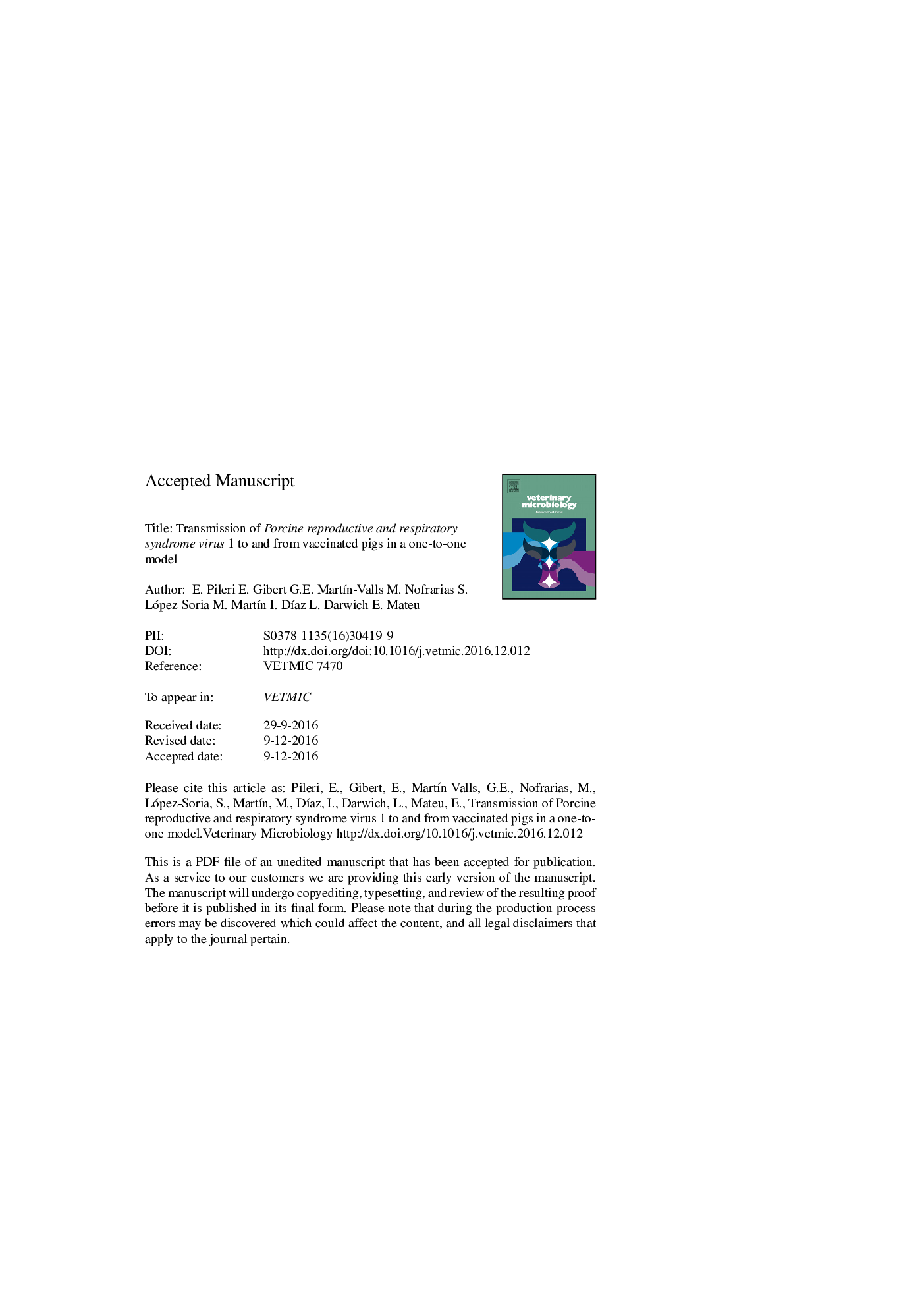| کد مقاله | کد نشریه | سال انتشار | مقاله انگلیسی | نسخه تمام متن |
|---|---|---|---|---|
| 5545115 | 1555322 | 2017 | 24 صفحه PDF | دانلود رایگان |
عنوان انگلیسی مقاله ISI
Transmission of Porcine reproductive and respiratory syndrome virus 1 to and from vaccinated pigs in a one-to-one model
ترجمه فارسی عنوان
انتقال ویروس سندرم تولید مثل و تنفسی 1 و از خوک های واکسینه شده در مدل یک به یک
دانلود مقاله + سفارش ترجمه
دانلود مقاله ISI انگلیسی
رایگان برای ایرانیان
کلمات کلیدی
ویروس سندرم تولید مثل و تنفسی انتقال، واکسیناسیون،
موضوعات مرتبط
علوم زیستی و بیوفناوری
علوم کشاورزی و بیولوژیک
علوم دامی و جانورشناسی
چکیده انگلیسی
The present study examined transmission by contact of Porcine reproductive and respiratory syndrome virus (PRRSV) 1 in a one-to-one model to vaccinated and unvaccinated pigs and from vaccinated infected pigs to other vaccinated pigs. The experiment started by randomly assigning weaned pigs to groups V (n = 24) and U (n = 26). V pigs were vaccinated with a commercial live attenuated PRRSV vaccine and the U animals were kept as unvaccinated controls. Twenty-eight days later, 6 U pigs were separated and allocated in individual boxes. The remaining 20 U pigs were intranasally inoculated with PRRSV isolate 3267 (from now on designated as seeder (S) pigs) and 48 h later were distributed in boxes where they were commingled with either V or U pigs in 1:1 groups (first contact phase), resulting in 6 S:U and 14 S:V pairs. As soon as a V pig was detected to be viremic because of contact with a S, the infected V (from now on designated as Vinf) was transferred (<24 h after detection) to a new pen where it was comingled with a new V pig (designated as V2) in a second contact phase. For the first contact phase, pigs were maintained 21 days at maximum and for the second contact phase the maximum exposure period was 14 days. Two V pigs tested positive for the vaccine virus (>99.5% similarity) when they were relocated with the corresponding V2 pigs and they were removed; thus, only 12 Vinf were finally considered. All V pigs (12/12) exposed to S animals became infected although the first detection of viremia occurred at 13.6 ± 3.6 days, one week later than in U (p < 0.05). Also, duration of viremia was shorter for Vinf compared to U, (5.5 ± 4.3 days versus 12.5 ± 2.7 days). The Vinf group showed remarkable individual variability: eight animals had a viremic period of 5 or less days (3.0 ± 1.4) while the remaining four had a longer viremic period of more than one week (10.8 ± 2.9). This situation was not observed in U. In the second contact phase, transmission from Vinf to V2 pigs occurred in 7/8 cases (87.5%). The mean duration of viremia for V2 was 4.8 ± 3.4 and two different patterns were again observed: two animals had viremias of 9-10 days and the rest averaged 3.0 ± 1.4 days (range: 2-5 days). Vaccinated groups Vinf and V2 had a significantly lower PRRSV shedding in oral fluids for at least the first 9 days after the onset of the viremia compared to U, and shedding for V2 was even significantly lower (p < 0.05) than shedding for Vinf. Our experimental design reproduced the worst-case scenario for evaluating the effect of vaccination and, under such conditions; it was still efficacious in slowering PRRSV transmission and decreasing the global viral load and particularly oral shedding.
ناشر
Database: Elsevier - ScienceDirect (ساینس دایرکت)
Journal: Veterinary Microbiology - Volume 201, March 2017, Pages 18-25
Journal: Veterinary Microbiology - Volume 201, March 2017, Pages 18-25
نویسندگان
E. Pileri, E. Gibert, G.E. MartÃn-Valls, M. Nofrarias, S. López-Soria, M. MartÃn, I. DÃaz, L. Darwich, E. Mateu,
